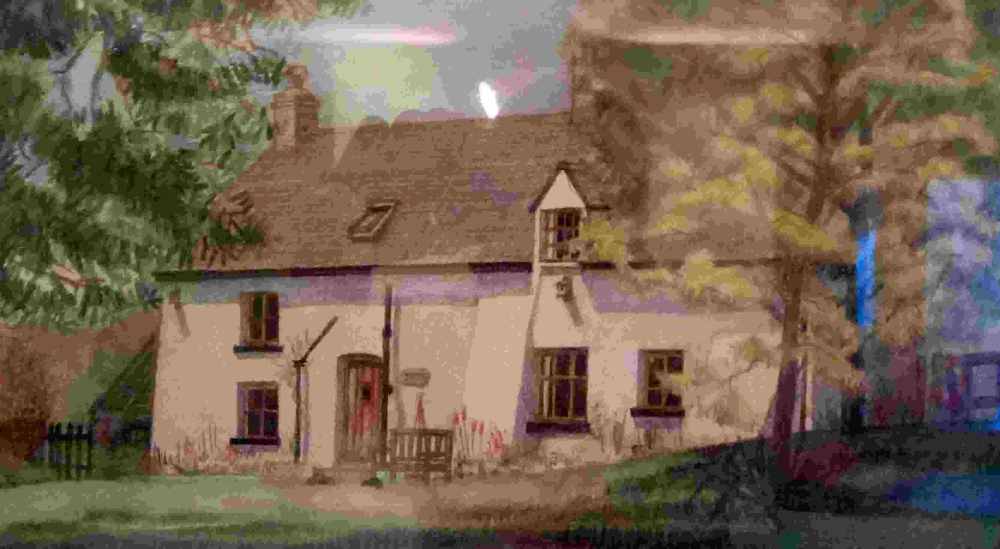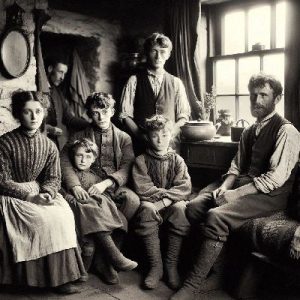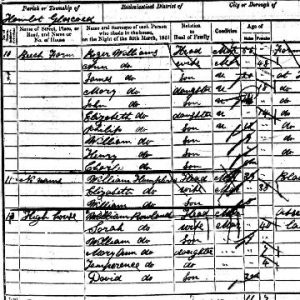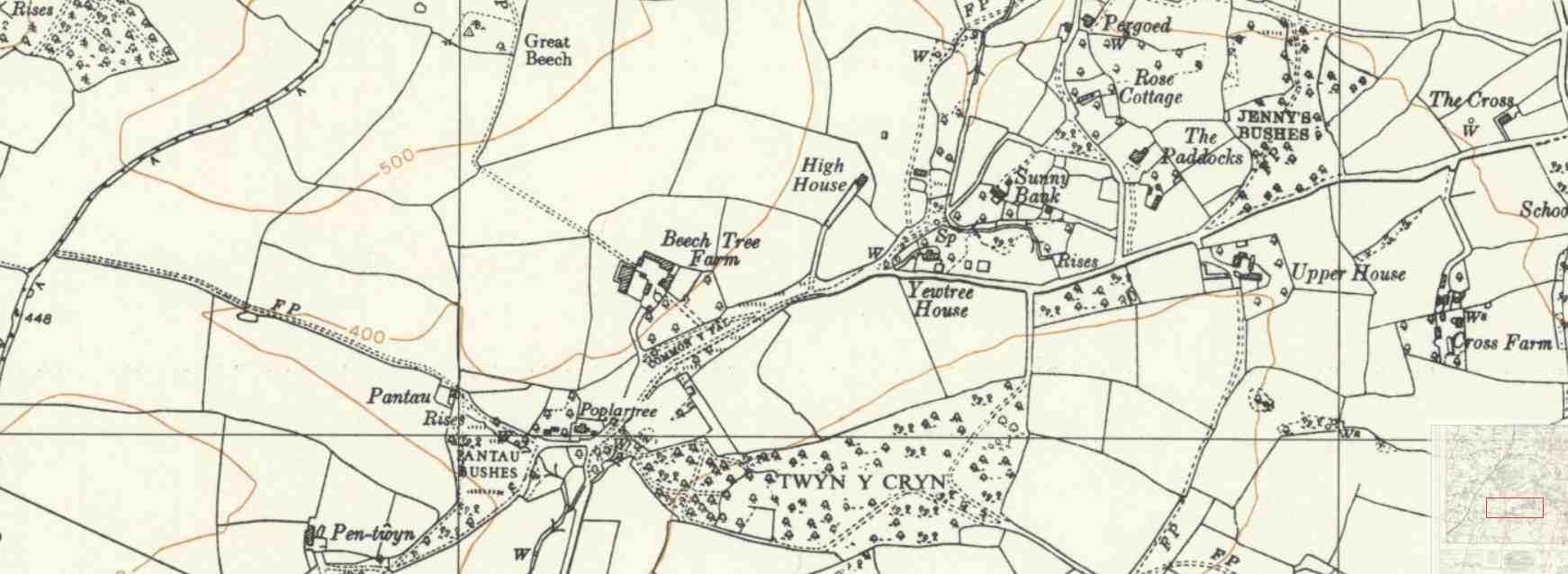
OVERVIEW: Beech farm, as it was known on the older censuses, dates back to approximately 1580. It was also known as “Big Beech Farm”, after the huge beech tree that for centuries was a noted local landmark (see also below – “The Great Storm”).
Beech Farm holds a special place in my heart, being the home of Elizabeth Williams, my 3 times Great Grandmother who was born here around 1836.
Nowadays the property is known as “Beechtree Farmhouse”, with a 20th century red brick house behind the old Farmhouse being the modern day “”Beech Farm””.”
Facts and Figures

Year of Construction
Early 17th century

First Recorded Residents and year
Widow of Joseph Harries: 1824

Residents at time of the 1851 census
Roger Williams, Ann nee Morgan and Family
Location

This 1964 map downloaded from the wonderful National Library of Scotland “Old maps” section, shows the location of Beech Farm.
Residents
Joseph and Mrs Harries
The first resident that I could find at Beech Farm is the “Widow of Joseph Harries”, in the Land Tax Assessments of 1823 and 1824. I don’t really know anything else about her, although I do know that a Joseph Harries was paying Land Tax in Glascoed at the time of the 1806 Land Tax Assessments. He appeared to be liable for less tax in that particular assessment, so if it is the same Joseph (likely I think) then he had managed to move up in the world before he died, probably farming additional fields, if taxation is anything to go by!
The Williams family of Beech Farm
Several of the people I have met with Glascoed roots seem to be descended, like me from the Williams family of Beech Farm. Roger Williams and Ann had a number of children, most of whom seemed to stay in Glascoed and marry Glascoed people.
From 1829 onwards and possibly up to 5 years earlier, Beech Farm was inhabited by the Williams family. Roger Williams and his wife Ann (nee Morgan). Roger’s parents were Phillip and Elizabeth Williams. Phillip had died in 1830 and Elizabeth in 1836 – both were buried at Mount Zion Chapel. It is quite possible that they farmed at Beech Farm before Roger inherited the property – this is my own speculation.
Roger was a native of Breconshire, being born near Crickhowell, c 1790, at a place called Cwmbychan – I haven’t been able to locate it on modern maps – maybe it was a farm? His brother, William though, appeared to have been born at Glascoed (according to the 1871 census) so his parents, Philip and Elizabeth must have been farming at Glascoed in 1806 too, around the time of William’s birth. I guess this record points to them, although cannot prove this for sure, or exactly where they were farming at this point.
The first we see of him is when he married Ann Morgan, a Glascoed girl, at Usk in 1830. They were certainly in residence at Beech Farm by 1832, when Roger was listed as the occupier on the Register of Electors of that year. He lived at the farm until his death on 11th March 1872.
They had seven children, James, Mary Ann, John, Elizabeth, Philip, William and Henry – all born at Glascoed. An eighth “son”, Charles was also listed on the 1851 census, although I suspect he was probably the son of Mary was 17 or 18 and unmarried at the time that Charles was born. This is speculation rather than proven fact. They weren’t the only babies born to the family at the farm; I know that my Great Grandmother, Mary Ann Arnold, was also born there in 1857, before her mam, Elizabeth got married.
It was definitely a working farm. In the next column you can read a couple of stories from the 19th century, recounted by Glyn Williams, from oral history (probably from his Grandfather, Henry Williams).
After Roger’s death, Ann continued as the farmer until 1884, with the help of her sons Henry and Philip. Henry married and moved away to his own farms by the time of the death of his mother in 1884.
Philip remained a confirmed bachelor up until his late forties when he married Ann, the daughter of William Gwatkin and Eliza Williams of Maes Mawr Farm in Glascoed. They married on 2nd August 1887 at St Woolos’, Newport. She had been recently widowed by Isaac Edward Lewis and brought five children from that marriage with her to Beech Farm to make it a noisy place again! William Isaac, Isabella, Florence, Ada and Beatrice. Philip and Ann rounded out the family by bringing two new children to the world, Richard (1885) and Annie Kate (1890). We see the family together on both the 1891 and 1901 censuses. Philip continued as the farmer until his death in January 1903.
I don’t know exactly when the farm passed on to the hands of the next owners, although according to the electoral records of 1909, Ann Williams (nee Gwatkin), Philip’s widow was still living there. The census also shows her there in 1911 with her son Richard Henry (aged 23 – “farmer’s son, working on farm, looking after farm”), and daughter Annie Kate (aged 20 – Farmer’s daughter, dairy work, dairy maid).
The Bradley family
I was informed by a contact that the Bradley family were farming at Beech Farm by 1910. I would imagine that the year given must have been approximated over the years, since we still see Ann Williams/ Gwatkin farming here in April 1911 – and in 1911, the Bradleys were still farming at Tregare, Monmouthshire. The births of their later children show us that the Bradleys must have moved to Beech Farm between 1915 and 1917.
“I am not even sure of the exact dates my family were in residence, apart from the fact my Uncle Ernest BRADLEY born there in 1917 farmed it all his married life. Coincidentally, my Aunt (his wife) died this month, leaving my Mother as the only living person now of that generation (aged 90). I can only guess that John William & Esther BRADLEY were at Beech Farm sometime between 1901-1910, and held it until recent years”. Thanks for the above information to Hazel! Any more info would be much appreciated.
John (born 30th May 1874 at Llanvihangel Ystern Llewern) was a Wheelwright by trade, although had become a farmer in the early 1900s. Esther (nee Jones, born 5th February 1880) was from Llangattock-Vibon-Avel. They married there on 9th February, 1898.
They had seven children by the time of the 1911 census, although only six were living with them at Coed Poeth, Tregare on census night, 1911. Those children were Arthur James (born 29th September 1898 at Llangattock Vibon-Avel), John Edward (born 13th March 1901 at Llanvetherine), Frank (born 13th December 1902 at Skenfrith), Annie Grace – also known as “Nancy” (born 9 Jan 1905 also at Skenfrith), William Gordon (born 20th November at Clodock, Herefordshire) and Edith (born 27th November 1909 at Tregare). John had taken up farming by this point. Their other child alive in 1911, Elizabeth Bradley, was staying with her Aunt Elizabeth Jones at Whitehall, Rockfield, Monmouthshire on census night. Elizabeth was born on 7th November 1899 at Llanvetherine.
On the 1921 census, John and Esther were still farming at Beech Farm along with their children Arthur and Frank (both “Assistants on Father’s farm”) along with Nancy and Edith.
Four more children were born in the 1910s. Firstly Walter, born on 22 September 1911 at Tregare. Margaret was born at Monkswood on 22 July 1915. Ernest Bryan Bradley was born on 16th May 1917 and Evelyn Mary on 6th November 1919. Both were born at Glascoed, presumably at Beech Farm, indicating that the Bradleys moved to Beech Farm somewhere between 1915 and 1917.
John and Esther appear on the Register of Electors at Beech Farm in 1922 and 1929. Arthur James Bradley was also registered to vote at the address in 1922 and Frank Bradley was a registered voter there in 1929, by which time it appeared that Arthur had moved on.
The National Register, taken on 29th September 1939, following the outbreak of World War II shows John and Esther Bradley still in residence with their family. John was a Farmer and Esther undertook “Unpaid Domestic” duties.
The children at home were:
1) Ernest B. Bradley (born 16th May 1917). He was an Assistant farmer.
2) Margaret Bradley (22nd July 1915) undertook “unpaid domestic” duties. She later became a Mullins by marriage on 15th July 1951.
3) Evelyn M Bradley (16th November 1919) was a “Student Physical College” and married a “Mr Williams” on 9th February 1958.
From Hazel’s information, Ernest continued as the farmer at Beech Farm for a decent portion of the 20th century, I assume. I also assume that he may have had the newer Beech Farm house built (although this is very much a guess and could be totally wrong!).
Recently I received a lovely email from the current occupant who explained that after moving to the farmhouse in 1996 that:
“Other than adding a pond to the garden and an en-suite to the main bedroom we haven’t changed it. It still has the very old meat hooks in the old kitchen and in what the Cadw man tells me would have been a room for handling bacon and herbs, but which I use as my office. When we took off some old woodchip wallpaper in the main living room some years ago we exposed what looks like a window lintel, but we decided not to get involved in excavating the wall to see if there was a hidden window, though we have left the lintel exposed. You are very welcome to visit any time you like, it would be nice to meet you.
The very old deeds are huge, they are the old table top documents so beloved of old lawyers and the copies are not great, they are very dark. I will have to find somewhere with a large copier, my little A4 copier won’t cut the mustard. I will however sit down and go through them and see what I can find out from them and I’ll drop you an email and let you know. My solicitor sent them to us when we moved in, but I just never really looked at them, although many years ago Roy Jones, who used to live in High House brought an old friend of his to the house. The old friend thought that his family had once been involved with the house but after looking at all the documents he concluded that they weren’t. He was in some way connected to the family of the sea captain who married a Zulu woman. Roy, who we fondly called Old Roy told us after he had left that his family included an African woman.
I’ve attached a photo of a painting of the house, done for me by an old neighbour who used to live in the barn conversion next door, now known as Ysybor Wen. It’s the barn to the right of the house as you look at it – the old historic one that would be of the same age as the house. It’s some years old now, but, save for the honeysuckle growing round the down pipe which is now a triffid, the house looks the same. I find it interesting that the house never appeared to have had a Welsh name. It’s now Beechtree Farm house to distinguish it from the new red brick farm house and the land, now known as Beech Farm, but I can’t find any evidence of it ever having a welsh name. Do you know why that would be?”
I’m afraid that I don’t know the answer to that question, although I guess that the farm was part of the Duke of Beaufort’s Estate. The residents themselves may well have used a Welsh name for the house, since some (certainly the Williams family) were Welsh speakers.
Records
Land Tax Assessments
- 1829 – Phillip Williams
- 1831 – Roger Williams.
Registers of Electors
- 1832 to 1872 – Roger Williams.
- 1889 – Philip Williams.
- 1909 – Ann Williams.
- 1922 – John, Esther and Arthur James Bradley.
- 1929 – John, Esther and Frank Bradley.
Censuses
- 1841, 1851, 1861, 1871 – Roger Williams
- 1881, 1891, 1901 – Philip Williams.
- 1911 – Ann Williams.
- 1921 – John Bradley.
- 1939 National Register – John Bradley.

